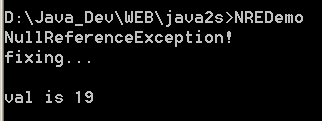Use the NullReferenceException

/*
C#: The Complete Reference
by Herbert Schildt
Publisher: Osborne/McGraw-Hill (March 8, 2002)
ISBN: 0072134852
*/
// Use the NullReferenceException.
using System;
class X {
int x;
public X(int a) {
x = a;
}
public int add(X o) {
return x + o.x;
}
}
// Demonstrate NullReferenceException.
public class NREDemo {
public static void Main() {
X p = new X(10);
X q = null; // q is explicitly assigned null
int val;
try {
val = p.add(q); // this will lead to an exception
} catch (NullReferenceException) {
Console.WriteLine("NullReferenceException!");
Console.WriteLine("fixing...\n");
// now, fix it
q = new X(9);
val = p.add(q);
}
Console.WriteLine("val is {0}", val);
}
}
Related examples in the same category